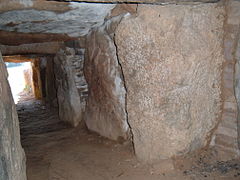Klekkende Høj
The klekkende høj is due to its double-chamber and two parallel accesses one of those rare double grave forms ( Danish Dobbelt- or Tvillingejættestue specified), in the manner only in Denmark and Skane occur. It originated in the Neolithic between 3500 and 2800 BC. BC as a megalithic system of the funnel beaker culture (TBK).
The passage grave is a form of Neolithic megalithic systems in which a structurally separated passage forms the access to the burial chamber. This form is primarily found in Denmark, Germany and Scandinavia, as well as occasionally in France and the Netherlands. Neolithic monuments are an expression of the culture and ideology of Neolithic societies. Their origin and function are considered to be the hallmarks of social development.
- Klekkende Høj
Outside view - southern access
description
The entrances to the facility located on the island of Møn south of Røddinge are over seven meters long and the chambers are around 4.5 m long. The Klekkende Høj is the only example of a chamber system with all axes forming right-angled, straight lines. Usually (e.g. at Troldhøj by Stenstrup ) the chambers form an obtuse angle and, with their long corridors, adapt to the round hill. Deviating from the usual shape of the passage graves on Møn, whose chambers are narrowest in the area of the entrances and widen trapezoidally towards both ends, the chambers and corridors of Klekkende Høj have right-angled and parallel long sides. The passage grave was opened in 1797 by the bailiff "Gérard Pierre Antoine de Bosc de la Calmette (1752-1803) from Marienborg". The archaeological excavation was one of the first in Denmark. They found amber beads , stone tools, pottery vessels, skeletal remains and parts of sacrificial animals. The burial chamber had remained untouched for thousands of years. The finds were donated to the new National Museum in Copenhagen in 1807 and are among the museum's first exhibits.
The grave construction was so perfect that neither water nor air could enter. When the hill was opened, the capstones had been removed and one was even blown up. When the grave chambers were closed, the capstones were returned to their original position, albeit with errors, as the building skills of the Stone Age were not available. This caused water damage, which could only be removed through an extensive complete renovation.
context
A total of 119 large stone graves from the Neolithic period are known on the only 231 km² islands of Møn and Bogø . 38 of them have been preserved and protected. 21 are passage graves of the TBK which between 3500 and 2800 BC. BC originated. The archaeologists estimate that the preserved large stone graves represent only about 10% of those originally built. On Møn and Bogø, more than 500 large stone graves were originally created over a period of only 700 years.
See also
literature
- Peter Vilhelm Glob : prehistoric monuments of Denmark . Wachholtz, Neumünster 1968, p. 74
- Karsten Kjer Michaelsen: Politics bog om Danmarks oldtid. Politiken, Copenhagen 2002, ISBN 87-567-6458-8 ( Politikens håndbøger ), p. 211
Web links
- Video (danish)
Individual evidence
- ↑ J. Müller In: Varia neolithica VI 2009 p. 15
Coordinates: 54 ° 56 ′ 10.4 " N , 12 ° 9 ′ 51.2" E



